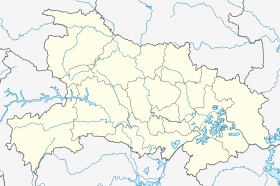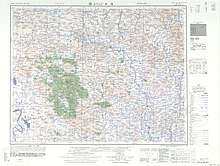Jingshan, Hubei
Jingshan is a county-level city of Jingmen City, in central Hubei Province, People's Republic of China. It is named after nearby Mount Jingyuan (京源山).[4] It is bordered on the north by the Dahong Mountain and on the south by the Jianghan Plain. The county has an area of over 3,520 square kilometres (1,360 sq mi). It has one economic development zone, jurisdiction 14 towns. Jingshan is located approximately one hour's drive from the provincial capital Wuhan.
Jingshan 京山市 Kingshan | |
|---|---|
 Jingshan Railway Station | |
 Jingshan Location in Hubei | |
| Coordinates: 31°08′N 113°07′E | |
| Country | People's Republic of China |
| Province | Hubei |
| Prefecture-level city | Jingmen |
| Towns | 14 |
| Area | |
| • Total | 3,520 km2 (1,360 sq mi) |
| Population (2016)[2] | |
| • Total | 645,900 |
| • Density | 180/km2 (480/sq mi) |
| Time zone | UTC+8 (China Standard) |
| Postal code | 431800[3] |
| Website | (In Chinese) Jingshan County government website |
| Jingshan, Hubei | |||||||
|---|---|---|---|---|---|---|---|
| Chinese | 京山市 | ||||||
| Literal meaning | Mount Jīngyuán City | ||||||
| |||||||
Geography and climate

Jingshan has a subtropical monsoon climate and four distinct seasons. There is abundant rainfall but the seasonal distribution is uneven. The annual mean temperature is 16.3 °C.
Administrative divisions
There are 14 towns in Jingshan:[5][6]
| Name | Chinese (S) | Hanyu Pinyin |
|---|---|---|
| Xinshi | 新市镇 | Xīnshì |
| Yongxing | 永兴镇 | Yǒngxīng |
| Caowu | 曹武镇 | Cáowǔ |
| Luodian | 罗店镇 | Luódiàn |
| Songhe | 宋河镇 | Sònghé |
| Pingba | 坪坝镇 | Píngbà |
| Sanyang | 三阳镇 | Sānyáng |
| Lulin | 绿林镇 | Lùlín |
| Yangji | 杨集镇 | Yángjí |
| Sunqiao | 孙桥镇 | Sūnqiáo |
| Shilong | 石龙镇 | Shílóng |
| Yonglong | 永漋镇 | Yǒnglóng |
| Yanmenkou | 雁门口镇 | Yànménkǒu |
| Qianchang | 钱场镇 | Qiánchǎng |
Population
In 2002, 636,100 people lived in Jingshan. 403,100 of them were rural inhabitants whilst 233,000 formed the urban population. 320,100 of them were male and 316,000 female. The central towns have a total population of 233,200 inhabitants, 15,500 of them are mobile. In Jingshan the population density is 181 people per km2 with an average life expectancy of 74.12 years.
By the end of 2016, 645,900 people lived in Jingshan; 332,272 male and 313,713 female.[7]
Natural resources
Land resources
At the end of 2002, the city had 98846.37 hectares (1482695.6 acres) of farmland (29.56% of the total area), 31776.07 hectares (476641.00 acres) of water (9.51%) and 43040.54 hectares of unused land (645608.10 acres) accounting for 12.88% of the total.
Mineral resources
Jingshan has rich mineral resources. After years of extensive geological studies, more than 20 kinds of minerals have been found in Jingshan. The main non-metallic mineral mines in the city include limestone (500 million tons), dolomite (700 million tons) and Silica (300 million tons).
Water resources
The rivers of Jingshan are mainly fed by surface water and groundwater. The annual precipitation averages 1179 mm and the average annual runoff adds up to 350.5 mm, equivalent to 1.173 billion cubic meters. There are more than 500 rivers, 68 of them more than 10 kilometers long. Inside the county, the Block Reservoir, Ponds contain a total 1.329 billion cubic meters of water.
Animal and plant resources
Major crops are rice, barley, broad beans, soybeans, and many varieties of corn . Native products are mainly mushrooms, fungi, bridge meters, chestnut, tea and seedless watermelons.
The flora in Jingshan derive from 73 branches, 146 genera and 247 species.
Pangolins, wolves, bifurcates, leopards, parrots and wildlife in general are protected according to law within the territory of the state.
Industry and economy
In 2005, the city achieved a GDP of 7.1 billion. There are more than 100 enterprises, eleven of which are 10 million euro enterprises. 39 of them are 10 million yuan enterprises. Yearly exports reached 48 million U.S. dollars in 2005.
Construction, machinery manufacturing, materials processing, textiles and garments, chemical metallurgy and food processing shape the five industrial clusters.
References
- "京山县地理概况" (in Chinese). Jingshan County government website. Retrieved 5 December 2017.
全县版图面积3520平方公里(含屈家岭管理区173平方公里,太子山林场75平方公里),约占湖北省总面积1.78%。
- "京山县人口民族" (in Chinese). Jingshan County government website. Retrieved 5 December 2017.
【人口民族】2016年底,全县总人口64.59万人,常住人口56.75万人,总户数20.491万户。总人口中:男性人口332272人,女性人口313713人,性别比105.91;乡村人口27.01万人,城镇人口28.23万人。全年出生人口6365人,其中男3140人、女3125人,出生率为9.73%;死亡人口3141人,死亡率4.79‰;自然增长率4.34‰,性别比103.7。
- "全国邮编区号搜索" (in Chinese). www.ip138.com 查询网. Retrieved 7 December 2017.
市、县、区名 湖北省荆门市京山县{...} 邮政编码 431800
- "京山县政区沿革" (in Chinese). Jingshan County government website. Retrieved 5 December 2017.
京山因县城东有京源山,省“源”字而得名。
- "京山县行政区划" (in Chinese). Jingshan County government website. Retrieved 5 December 2017.
【行政区划】京山县辖新市、永兴、曹武、罗店[、]宋河、坪坝、三阳、绿林、杨集、孙桥、石龙、永隆[sic]、雁门口、钱场等14个镇和京山经济开发区、京山温泉新区,356个村民委员会,2343个村民小组,30个社区居民委员会。
- 2017年统计用区划代码和城乡划分代码:京山县 [2017 Statistical Area Numbers and Rural-Urban Area Numbers: Jingshan County]. National Bureau of Statistics of the People's Republic of China. 2017. Retrieved 15 August 2018.
统计用区划代码 名称 420821100000 新市镇 420821101000 永兴镇 420821102000 曹武镇 420821103000 罗店镇 420821104000 宋河镇 420821105000 坪坝镇 420821106000 三阳镇 420821107000 绿林镇 420821108000 杨集镇 420821109000 孙桥镇 420821110000 石龙镇 420821111000 永漋镇 420821112000 雁门口镇 420821113000 钱场镇 420821170000 开发区(镇) 420821449000 温泉新区 420821450000 太子山 420821451000 罗汉寺办事处 420821452000 长滩办事处 420821453000 何集办事处 420821455000 易家岭办事处 420821456000 屈家岭经济开发区 420821598000 原种场镇
- "京山县人口民族" (in Chinese). Jingshan County government website. Retrieved 5 December 2017.
【人口民族】2016年底,全县总人口64.59万人,常住人口56.75万人,总户数20.491万户。总人口中:男性人口332272人,女性人口313713人,性别比105.91;乡村人口27.01万人,城镇人口28.23万人。全年出生人口6365人,其中男3140人、女3125人,出生率为9.73%;死亡人口3141人,死亡率4.79‰;自然增长率4.34‰,性别比103.7。